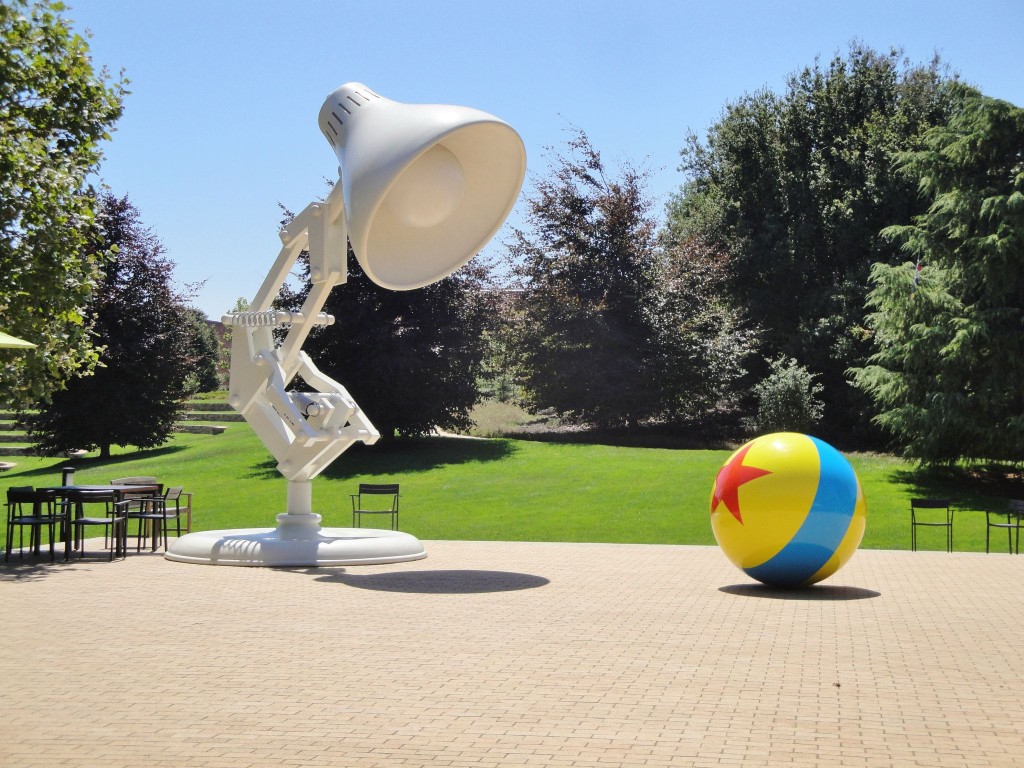9 Ways That Pixar Cultivates Creative Culture (& You Can Too)
Posted in: Business
I’ve been a massive Pixar fan as far back as I can remember. As a kid growing up in the 90’s, their creations were the soundtracks, images and imaginary friends of my childhood.
Even as I got older, Pixar films had that distinctive way of resonating with people of all ages and making you cheer for their loveable, unique characters. They made you feel like a kid again, while also making grown adults bawl like a baby while walking out of a children’s movie. (Yes, I am talking about the opening sequence of Up.)
However, as I got older, I began to appreciate Pixar as a business, not just a creator of my favorite films. This is a movie studio that has not only managed to design the digital animation world as we know it today, but also had an unbelievable streak of box-office hits, a notoriously happy group of employees, a few Oscar wins under their belt, and above all, a reputation for unfaltering creativity and inspiration. They had to be too good to be true, right?
I was lucky enough to find out for myself when I was invited to tour Pixar Studios a couple years ago. After a day of walking through their incredibly thought-out headquarters (designed by Steve Jobs, former Pixar CEO, himself), it was confirmed – Pixar had truly mastered the art of creative culture. It was everywhere, from their open atrium that was designed to create accidental gatherings between different employees, to their completely awesome custom employee office spaces. (My favorite was a hidden speakeasy room named “The Love Lounge.”)
Since that tour, President of Pixar Animation and Disney Animation, Ed Catmull, has put down on paper the principles and thoughts that have made Pixar the creative powerhouse that it is today. His book, Creativity, Inc., is truly a go-to resource for anyone looking to own creative culture, whether you are managing a multi-million dollar business, or you’re an independent artist looking to inspire yourself each day. Here are just a few of my favorite tips that Catmull gives for overcoming the unseen forces that stand in the way of true inspiration.
1. Always try to hire people smarter than you are
“I’ve made a policy of trying to hire people who are smarter than I am,” Catmull wrote. “The obvious payoffs of exceptional people are that they innovate, excel, and generally make your company – and, by extension, you – look good. But there is another, less obvious, payoff that only occurred to me in retrospect … By ignoring my fear, I learned that fear was groundless. Over the years, I have met people who took what seemed the safer path and were the lesser for it.”
In the end, in order to ensure that you succeed, you need to attract the sharpest minds possible – especially those sharper than your own. In order to attract these minds, Catmull suggests that you must put your insecurities away and, “always take a chance on better, even if it seems threatening.”
2. Fail early and fail fast
“Failure isn’t a necessary evil. In fact, it isn’t evil at all. It is a necessary consequence of doing something new.” Catmull went on to cite Andrew Stanton (a writer and director at Pixar known for movies like A Bug’s Life, Finding Nemo and WALL-E) as a steadfast believer in being wrong as fast as you can. Stanton chooses to think of failure like learning to master an instrument. “You wouldn’t say to somebody who is first learning to play the guitar, ‘You better think really hard about where you put your fingers on the guitar neck before you strum, because you only get to strum once.’”
However, despite the fact that many people at Pixar have heard the “fail fast” mantra echoed by Catmull and Stanton, many still miss the point (as do many others in the work world). “They think it means to accept failure with dignity and move on. The better, more subtle interpretation is that failure is a manifestation of learning and exploration … trying to avoid failure by out thinking it dooms you to fail,” Catmull explains.
3. Don’t take shortcuts
“When filmmakers, industrial designers, software designers, or people in any other creative profession merely cut up and reassemble what has come before, it gives the illusion of creativity, but it is craft without art,” Catmull says. “Craft is what we are expected to know; art is the unexpected use of our craft. Even though copying what’s come before is a guaranteed path to mediocrity, it appears to be a safe choice, and the desire to be safe – to succeed with minimal risk – can infect not just individuals but also entire companies.”
However, while you may realize that there is a true need for change and innovation in your company, and even if there is a general agreement that change needs to happen, don’t assume that those changes will automatically take place without encouragement. “It takes substantial energy to move a group, even when all are on board.”
4. Avoid freezing up when overwhelmed
Everyone has their occasional stressful days at work. However, the key to getting through these hard days is to find the secret trick to avoid “freezing up” when they occur. “One trick I’ve learned is to force myself to make a list of what’s actually wrong,” Catmull writes. “Usually, soon into making the list, I find I can group most of the issues into two or three larger all-encompassing problems. So it’s really not all that bad. Having a finite list of problems is much better than having an illogical feeling that everything is wrong.”
Pete Doctor (Pixar writer and director known for films such as Monsters, Inc. and Up) has also come up with a few tried and true methods for helping to manage coworkers through the fears and stress that can often pop up at work: “Sometimes in meetings, I sense people seizing up, not wanting to even talk about changes,” he says. “So I try to trick them. I’ll say, ‘This would be a big change if we were really going to do it, but just as a thought exercise, what if…’ Or, ‘I’m not actually suggesting this, but go with me for a minute…’ If people anticipate the production pressures, they’ll close the door to new ideas – so you have to pretend you’re not actually going to do anything, we’re just talking, just playing around. Then if you hit upon some new idea that clearly works, people are excited about it and are happier to act on the change.’”
5. Provide good notes and feedback
Many people often provide creative criticism to their coworkers on projects and presentations. However, Catmull advises against this and instead promotes “good notes” as the best way to provide feedback. “A good note says what is wrong, what is missing, what isn’t clear, what makes no sense. A good note is offered at a timely moment, not too late to fix the problem … Most of all, though, a good note is specific.”
What is the distinction between these two forms of feedback? According to Stanton, “There’s a difference between criticism and constructive criticism. With the latter, you’re constructing at the same time that you’re criticizing. You’re building as you’re breaking down … whatever notes you’re giving should inspire the recipient.”
6. Trust your coworkers and be honest
It is our natural urge to suppress when we are confused in a project or are not sure where we are headed. However, this should be avoided in the workplace. “‘Careful messaging’ to downplay problems makes you appear to be lying, deluded, ignorant, or uncaring. Sharing problems is an act of inclusion that makes employees feel invested in the larger enterprise,” Catmull wrote.
Along the same lines, be sure that you are truly trusting your coworkers in your projects and assignments – not just saying that you do so. “Trust doesn’t mean that you trust that someone won’t screw up – it means you trust them even when they do screw up.”
7. Don’t be afraid to set limits
Many people in creative industries often think of limits as restrictions or rules put on their creativity. However, limits can often times create a positive creative impact as well – especially if you find that you have a lot of things you want to do, but not enough resources. Pixar’s Chief Creative Officer, John Lassater, found one way to use limits to his advantage when there was a lot of character animation work to be done on The Incredibles film, but not enough man hours in the day.
“John’s system consisted of popsicle sticks stuck to a wall with Velcro,” Catmull shared. “Each stick represented a person-week … the amount of work a single animator could accomplish in a week’s time. A bunch of sticks would be lined up next to a particular character for easy reference. A glance at the wall would tell you: If you use that many Popsicle sticks on Elastagirl, you’ll have to spend less on Jack-Jack. And so on. ‘Brad would come to me and say: ‘we’ve got to have this done today,’’ John recalls. ‘And I could point to the wall and say, ‘Well, you need another stick, then. Where are you going to take the stick from? Because we only have so many.’’ I see this as a great example about the positive creative impact of limits.”
8. Create mental models to lead you through creative problems
Just as many people face stressful days at work, we also are prone to “brain fart” days at work. Days where, no matter how many cups of coffee you have, or how much research you do, you’re just stuck at a dead end and can’t see the light at the end of the tunnel. Catmull is a big believer in encouraging employees to create “mental models” to help assist them through this darkness.
“Bob Peterson, who has helped solve creative problems on almost every Pixar film … compared making a movie to an archaeological dig … the idea that as you progress, your project is revealing itself to you,” he wrote. “’You’re digging away, and you don’t know what dinosaur you’re digging for,’ Bob says. ‘Then, you reveal a little bit of it. And you may be digging in two different places at once and you think what you have is one thing, but as you go farther and farther, blindly digging, it starts revealing itself. Once you start getting a glimpse of it, you know how better to dig.”
However, it’s also important that, during this excavation, you don’t wander off of your path or get too attached to ideas that don’t relate back to your bigger project. “Not every bone you unearth will necessarily belong to the skeleton you are trying to assemble. (There may be the bones of several different dinosaurs – or stories – mixed up in your dig site.) The temptation to use everything you find, even if it doesn’t fit, is strong. After all, you probably worked hard to dig each element up. But if you are discerning and rigorous in your analysis of each piece – if you compare it to the bits you’ve found already to see if it’s a match – your movie or project will reveal itself to you.”
9. Remember that the future is not a destination – it’s a direction
Above all, Catmull reinforced many times the fact that creativity and inspiration are a constant journey that require finessing and honing. “It is our job, then, to work each day to chart the right course and make corrections when, inevitably, we stray … To keep a creative culture vibrant, we must not be afraid of constant uncertainty. We must accept it, just as we accept the weather. Uncertainty and charge are life’s constants. And that’s the fun part.”
Do you agree with all of these tips for fostering creative culture? Which point stuck out to you the most? Be sure to let us know in the comments below! Also be sure to check out Ed Catmull’s “Creativity, Inc.” if you are interested in learning more about creativity and inspiration behind Pixar Animation.


























